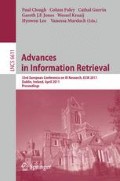Abstract
The widespread use of social media is regarded by many as the emergence of a new highway for information and news sharing promising a new information-driven “social revolution”. In this paper, we analyze how this idea transfers to the news reporting domain. To analyze the role of social media in news reporting, we ask whether citizen journalists tend to create news or peddle (re-report) existing content. We introduce a framework for exploring divergence between news sources by providing multiple views on corpora in comparison. The results of our case study comparing Twitter and other news sources suggest that a major role of Twitter authors consists of neither creating nor peddling, but extending them by commenting on news.
Access this chapter
Tax calculation will be finalised at checkout
Purchases are for personal use only
Preview
Unable to display preview. Download preview PDF.
References
Barrón-Cedeño, A., Eiselt, A., Rosso, P.: Monolingual Text Similarity Measures: A Comparison of Models over Wikipedia Articles Revisions. In: Proc. of ICON 2009, pp. 29–38. Macmillan, Basingstoke (2009)
Cha, M., Haddadi, H., Benevenuto, F., Gummadi, K.P.: Measuring User Influence in Twitter: The Million Follower Fallacy. In: Proc. of ICSWM 2009. AAAI, Menlo Park (2009)
Cha, M., Haddadi, H., Benevenuto, F., Gummadi, K.P.: Measuring user influence in twitter: The million follower fallacy. In: Proc. of ICWSM 2010. AAAI, Menlo Park (2010)
Church, K.W., Hanks, P.: Word association norms, mutual information, and lexicography. Computational Linguistics 16(1), 22–29 (1990)
English, E.O., Brown, P.E., Pietra, V.J.D., Mercer, R.L., Pietra, S.A.D., Lai, J.C.: An estimate of an upper bound for the entropy of English. Computational Linguistics 18, 31–40 (1992)
Esuli, A., Sebastiani, F.: Sentiwordnet: A publicly available lexical resource for opinion mining. In: Proc. of LREC 2006. LREC (2006)
Gladwell, M.: Small change: Why the revolution will not be tweeted (2010). New Yorker Magazine (October 2010)
Grossman, L.: Iran protests: Twitter, the medium of the movement. Time Magazine (June 2009), http://www.time.com/time/world/article/0,8599,1905125,00.html
Huberman, B.A., Romero, D.M., Wu, F.: Social networks that matter: Twitter under the microscope. ArXiv e-prints (December 2008), http://arxiv.org/abs/0812.1045
Java, A., Song, X., Finin, T., Tseng, B.: Why we twitter: understanding microblogging usage and communities. In: Proc. of WebKDD/SNA-KDD 2007, pp. 56–65. ACM, USA (2007)
Kilgarriff, A.: Comparing corpora. International Journal of Corpus Linguistics 6, 1–37 (2001)
Kullback, S., Leibler, R.A.: On information and sufficiency. The Annals of Mathematical Statistics 22(1), 79–86 (1951)
Lafferty, J., Zhai, C.: Probabilistic relevance models based on document and query generation. In: Language Modeling and Information Retrieval, pp. 1–10. Kluwer, Dordrecht (2002)
Leskovec, J., Backstron, L., Kleinberg, J.M.: Meme-tracking and the dynamics of the news cycle. In: Proc. of KDD 2009, pp. 497–506. ACM, New York (2009)
Prasad, J., Paepcke, A.: Coreex: content extraction from online news articles. In: Proc. of CIKM 2008, pp. 1391–1392. ACM, New York (2008)
Shirky, C.: How social media can make history. TED Talk (June 2009), http://www.ted.com/talks/clay_shirky_how_cellphones_twitter_facebook_can_make_history.html
Verspoor, K., Cohen, K.B., Hunter, L.: The textual characteristics of traditional and open access scientific journals are similar. BMC bioinformatics 10(1), 183+ (2009)
Zhao, D., Rosson, M.B.: How and why people twitter: the role that micro-blogging plays in informal communication at work. In: Proc. of GROUP 2009, pp. 243–252. ACM, New York (2009)
Author information
Authors and Affiliations
Editor information
Editors and Affiliations
Rights and permissions
Copyright information
© 2011 Springer-Verlag Berlin Heidelberg
About this paper
Cite this paper
Subašić, I., Berendt, B. (2011). Peddling or Creating? Investigating the Role of Twitter in News Reporting. In: Clough, P., et al. Advances in Information Retrieval. ECIR 2011. Lecture Notes in Computer Science, vol 6611. Springer, Berlin, Heidelberg. https://doi.org/10.1007/978-3-642-20161-5_21
Download citation
DOI: https://doi.org/10.1007/978-3-642-20161-5_21
Publisher Name: Springer, Berlin, Heidelberg
Print ISBN: 978-3-642-20160-8
Online ISBN: 978-3-642-20161-5
eBook Packages: Computer ScienceComputer Science (R0)

